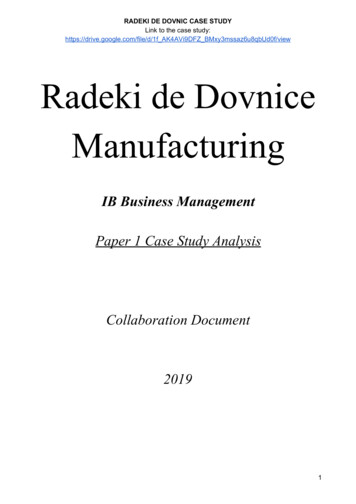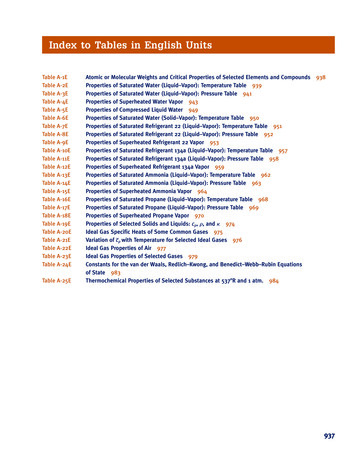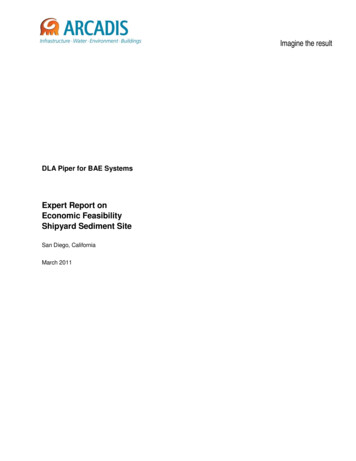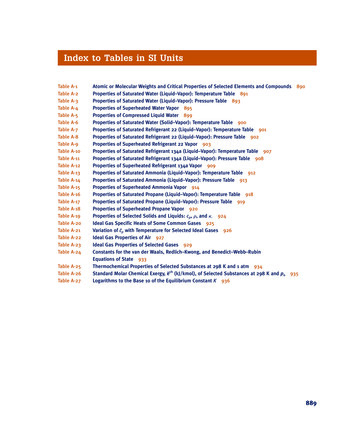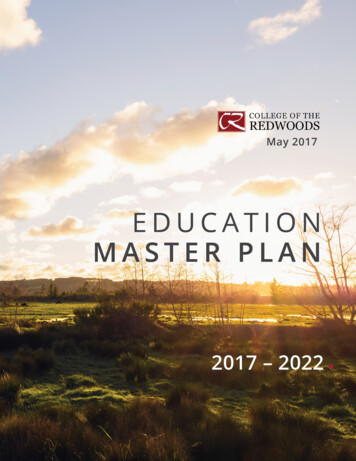
Transcription
Table of ContentsPresident’s Message . 2Mission. 3Vision . 3College History . 3Goals & Strategic Initiatives . 4Introduction . 6Strategic Visioning Focus Groups . 6Strategic Vision. 7Education Master Planning Process . 8Education Master Planning Committee Members . 8Education Master Plan Stakeholder Input . 9Data to Inform Planning. 10High School Students. 11Labor Market Data . 12Enrollment Trends . 14Progress of Existing Plans . 18Appendix A: SWOT ANALYSES . 19Strengths & Opportunities: Education Master Planning Committees. 19SWOT Analysis: Del Norte Campus . 20Appendix B: Student & Employee Input Summary. 22Appendix C: Emerging Focus Areas . 26Appendix D: Education Master Planning Survey & Results . 27Appendix E: 2012-2017 Planning Progress Updates . 301
President’s MessageCollege of the Redwoods engaged in a process to develop a revised EducationalMaster Plan that is long-range, comprehensive and that will serve as the District’sblueprint for 2017-2022. This Education Master Plan is intended to guide instructionaland service program development, decisions about growth, resource allocation at boththe District and campus/site levels, and continue to link budget to planning.The Education Master Plan incorporates existing work of the college by taking a freshlook at factors impacting our District and external environment, and offers a set ofrecommendations based on research. The recommendations from the EducationMaster Plan will require additional consideration given current and future planning.Keith Snow-Flamer, Ph.D.President2
MissionCollege of the Redwoods puts student success first by providing accessible and relevantdevelopmental, career technical, and transfer education.The College partners with the community to contribute to the economic vitality and lifelonglearning needs of its service area.The College continually assesses student learning and institutional performance and practices toembrace diversity, to encourage a healthy community environment and to improve upon theprograms and services we offer, all to promote student learning.VisionCollege of the Redwoods is a learning community where lives are transformed.College HistoryThe Redwoods Community College District was formed in January of 1964 by an election of thevoters of Humboldt County. A bond issue of 3,600,000 was passed for the initial construction ofwhat is now the college’s Eureka Campus.From 1965-1967, the college offered courses and programs on the campus of Eureka HighSchool. More than 1800 students registered at the College in 1965-66. The initial staff of thecollege consisted of 31 full-time faculty and administrative staff and approximately 85 part-timefaculty.In May of 1975, the residents of coastal Mendocino County voted for annexation into theRedwoods District, and in July of 1978, Del Norte County joined the district.The initial construction of the college’s Eureka Campus, seven miles south of the city of Eureka,began in 1968 and was completed in 1975. The Del Norte Education Center in Crescent City wasconstructed in 1981; and the Mendocino Education Center, just south of Fort Bragg, wasconstructed in 1986. The college also maintains the Klamath-Trinity Instructional Site on theHoopa Indian Reservation, approximately 60 miles northeast of Eureka and the GarbervilleInstructional Site, approximately 70 miles south of Eureka.The college celebrated its 50th anniversary in 2014.3
Goals & Strategic InitiativesStudent Success, Access & EquityEngage all StudentsEngage in excellent communication, coordination,and collaboration across campuses. Create an atmosphere where students feelwelcome and wanted Develop clear and consistent avenues ofcommunication Improve the effectiveness of tele-conferencingProvide accessible, affordable, high-quality education. Increase outreach to potential students in thecommunity, with increased attention on attractingstudents who will add to the diversity of the studentpopulation Provide cost-saving opportunities for students Increase professional development opportunities forfaculty and staff Promote pedagogical innovation Implement practices that lead to the hiring of staffand faculty who will add to the diversity of thecollege community Offer regionally-relevant programsEngage and empower students, particularly thosefrom underrepresented communities. Offer culture-specific programming Offer more events promoting and educatingcultural awareness Support student clubs more effectivelyEffectively use all learning modalities to provide studentsthe knowledge and skills they need to succeed. Enhance quality and expand access to distancelearning education Expand support services for online students Increase opportunities to internship and fieldworkprogramsCommunity Partnerships & Workforce TrainingEffectively respond to regional workforce needsthrough workforce training. Re-focus the Adult education program toemphasize non-credit to credit mobility Strengthen the collaboration of Adult andCommunity Education to respond to shortterm training needsDeliver strong individual support for students Broaden learning support opportunities includingtutoring and peer mentorship Grow the retention alert program and follow-upservices Strengthen support for students on probation Strengthen psychological support servicesEffectively partner with community stakeholders torespond to the needs of the community. Partner with employers and participate incommunity initiatives for economic growth Partner with high schools & Humboldt StateUniversity Partner with community-based organizationssuch as St. Joseph and Sutter Coast Hospitals Strengthen partnerships with local institutionssuch as Pelican Bay State PrisonPromote and encourage a learning community amongstudents, faculty, and staff. Strengthen communication and working relationshipbetween instruction and student development Increase programming and events that engagestudents throughout the DistrictServe as a hub of cultural, social, and economicactivities. Increase the number of community events Continue to expand branding efforts Intensify marketing and outreach efforts, andelevate the profile of CR in the regionStrive to eliminate achievement gaps across studentgroups. Enhance support of basic skills students Carry out and evaluate the Student Equity Plan Integrate student success planning efforts (e.g.,SSSP, SEP, BSI), such as for placement andsupplemental instruction Offer more student-achievement related professionaldevelopment opportunitiesEstablish partnerships that enhance success bysupporting the safety, health, and wellness of ourstudents. Fortify efforts regarding food insecurity Support student transportation needs Promote a safe and respectful campus climate4
Institutional Effectiveness & PlanningEmploy state-of-the-art technology, equipment,and facilities throughout the District to supportlearning and institutional performance. Improve technology throughout the District Carry out technology infrastructure upgradesat each location Carry out facility infrastructure upgrades ateach locationEmploy clear and transparent processes for coreoperations and decision-making. Assess all College processes Enhance the resource request and budgetingprocess Review and revise website content regularly Develop a plan for routinely scheduledanalysis of program relevance & health5
IntroductionThe Education Master Plan is updated every five years to reflect the needs of students,employees and the community. Once in place, the new Education Master Plan guidesCollege of the Redwoods (CR) to make sure that we are strategically advancing theachievement of our Mission.The education master planning process resulted in the following strategic goals andinitiatives to be achieved in 2017-2022. These strategic goals and initiatives were carefullychosen and reflect the most representative, important, and aspirational yet realistic goalsand objectives.The Board of Trustees led the College through a strategic visioning process that resulted ina set of strategic visioning statements that formed the basis from which our strategic goalswere developed. Starting on August 2016, the Board of Trustees worked with consultantsfrom the Cascadia Center for Leadership and the College’s Office of Institutional Researchto hold a series of focus group sessions gathering input from stakeholders.Strategic Visioning Focus GroupsThe College of the Redwoods’ Board of Trustees committed to moving the District fromwhere it is now to where it needs to go — by providing a strategic vision. Underlying thestrategic vision is the promise to provide a student-centered environment and to focus allcollege staff and resources on student learning, student development, and student success.The College of the Redwoods Vision Statement below reflects this. The Vision reflectsinput that has been gathered from the college community and the Board of Trustees.Focus group sessions took place at a variety of locations throughout the region.Klamath-Trinity Site in Hoopa, October 24, 2016o Audience: Students, faculty, staff, and community membersDel Norte Campus in Crescent City, November 16, 2016o Mid-day audience: Faculty, staffo Evening audience: Community members, faculty, studentsEureka Campus, November 18, 2016o Audience: Faculty, staff, studentsHumboldt Area Foundation, Eureka, November 30, 2016o Audience: Community members6
Following the sessions, the Office of Institutional Research transcribed the sessions andsynthesized the data. Consultants from the Cascadia Center for Leadership used thesynthesized data from all of the sessions to develop a draft strategic vision with statementsthat motivated the college’s strategic goals. The draft strategic vision was then taken to theBoard of Trustees, faculty, and staff throughout the District for revisions from Januarythrough April 2017.The resulting strategic vision and strategic goals were approved by the Board of Trustees attheir April 11, 2017 meeting.Strategic VisionCollege of the Redwoods puts student success first by providing accessible and relevantdevelopmental, career technical, and transfer education.We provide accessible, affordable, high quality, higher education in our region.We are leaders in the effective use of all learning modalities (e.g., classroom, distancelearning, internships, fieldwork) to provide students the knowledge and skills they need tosucceed.We promote and encourage a learning community among students, faculty, and staff.We deliver strong individual support and mentoring for students.We achieve equity in all areas of student success.The College partners with the community to contribute to the economic vitality and lifelonglearning needs of its service area.Our workforce training responds to regional workforce needs.Our graduates can find opportunities in the local region that allow them to become valued,contributing members of the community.We have vibrant partnerships with all community stakeholders (e.g., employers, highschools, HSU) so that we can respond to the existing and emerging needs of students andthe community.The communities we serve see CR as a “hub” of cultural, social, and economic activities.We have established partnerships that enhance success by supporting the safety, health, andwellness of our students.The College continually assesses student learning and institutional performance and practices toembrace diversity, to encourage a healthy community environment and to improve upon theprograms and services we offer, all to promote student learning.We are a flexible and nimble organization, able to assess and respond effectively to thechanging needs of our students and our community.We employ state-of-the-art technology, equipment, and facilities throughout the District tosupport learning, communication, and institutional performance.7
We understand the unique nature of each campus center and allow them the autonomy tomeet campus and community needs, and ensure that decision-making is inclusive andservices are equitable.We have clear and transparent processes for core operations and decision-making.We have excellent communication, coordination, and collaboration across campuses.Our students, faculty, staff, Board, and curricula reflect the diversity of the communities weserve and are culturally sensitive, respectful, and proficient.We value and nourish student engagement and empowerment, and we are inclusive ofunderrepresented student communities.Education Master Planning ProcessIn addition to the visioning process led by the Board of Trustees, the College developed anEducation Master Planning Steering Committee in fall 2016.Education Master Planning Committee MembersMark Winter, Interim Vice President of Instruction & Student Development (cochair)Angelina Hill, Director of Institutional Effectiveness (co-chair)Connie Wolfsen, Academic Senate Co-President (co-chair)Lee Lindsey, Vice President of Administrative ServicesSeven Roper, Director of IT and Facilities PlanningAhn Fielding, Executive Director of Community & Economic DevelopmentCindy Hooper, FacultyHilary Reed, FacultyThe Education Master Planning Committee also included four subcommittees made up offaculty, staff, and alumni that met to give input related to the following areas:Programs/Degrees and OutcomesInstructional InnovationInfrastructure and ResourcesStudent ServicesThe Education Master Planning Steering Committee and each of the subcommittees beganwith a review of internal and external scanning data. They went on to evaluate how thecollege can capitalize on strengths and opportunities, and minimize weaknesses and treatsby conducting a SWOT analysis. The strengths and opportunities identified can be found inAppendix A.8
The Educational Master Planning committees reviewed and analyzed the internal andexternal scanning data (included later in this report) from the Office of InstitutionalResearch. Additional input was gathered in a variety of ways.Education Master Plan Stakeholder InputTables were set up to gather input from students during the month of April 2016. Studentswere given three stickers and asked to place them next to what they thought should be thecollege’s top priorities for the next five year. Areas receiving the greatest number ofstickers included diversity, inclusion & equity; the dining hall; job training; and classroomtechnology.Focus group discussions were held at the Eureka and Del Norte campuses in March 2016.Advances in technology was the most frequently discussed topic. This includedimprovements to wifi, distance education, and computer labs. Improving student serviceswas the second most discussed topic. Services such as career training, and more support foreconomically disadvantaged were included in these discussions. Enhancing student successwas another widely-discussed area, and suggestions to improve student success includedoffering clear student pathways, and learning communities.Appendix B provides a summary of this input.The input from faculty, staff, and students (SWOT analyses, committee discussions)resulted in a set of emerging focus areas seen in Appendix C. The emerging focus areaswere used by the Education Master Planning Committee to create a survey. The emergingfocus areas were flushed out into 15 concentrations. Faculty and staff were asked toidentify the 8 they considered top priority, and indicate them in order of priority. Theconcentrations identified by the greatest number of people as top priority both fell withinthe student success theme: Developing clear pathways for students to obtain their education goal (e.g., transfer,employment. Engage in practices to enhance student persistence.Growing CR’s Community and Economic Development Program (e.g., job-related training,lifelong learning), and enhancing the technology infrastructure (e.g., network, data storage,bandwidth) were also rated as high priority, but were somewhat distant in overall rankingsfrom the concentrations related to student success. The survey questions and results areprovided in Appendix D.9
Data to Inform PlanningThe Humboldt County Population Report projects very slow growth in Humboldt Countythrough about 2025. A low birth rate in the county accounts for a shrinking number ofstudents in the 0-16 age group. This leads to the somewhat shrinking graduate class sizesseen below. Population growth is due to a growth in ages 65 and over, as well as growth inthe Hispanic community. The percentage of the population is expected to becomeincreasingly less Caucasian through 2060.Humboldt County Population ReportJon Haveman, Marin Economic ConsultingMay rts/Population Humboldt County.pdfThirty-five percent of CR’s fall 2015 student body lived within Eureka area codes, mostlyfrom 95501 (18%). Other major area codes correspond to the cities of Arcata, Fortuna,Crescent City, McKinleyville, Hoopa, and Ferndale. The following table shows the ZIPcodes in which CR’s fall 2015 students reside. The largest city within each ZIP code isshown, as well as the proportion of students within each ZIP code as compared to CR’s fall2015 headcount.Top ZIP Codes (fall 2015)ZipCodePrimary City#95501 Eureka94895503 Eureka72795521 Arcata60195540 Fortuna54495531 Crescent City48695519 McKinleyville 41995546 Hoopa11495536 Ferndale8895502 Eureka8795551 Loleta7895562 Rio Dell7395570 Trinidad3995567 Smith River3495524 Bayside3495518 Arcata33Total Top Zip Codes 4305Total All Others 1048Total 535310% %
High School StudentsThe following table displays high schools from which students of College of theRedwoods’ fall 2015 student body originate. Ethnic distribution per “feeder” high school isalso presented. The 15 high schools listed represent the source of about 40 percent of thecolleges fall 2015 students. Ten percent of students graduated from Eureka Senior HighSchool. The largest equity group from each high school is Caucasian, except Hoopa ValleyHigh School, from which 81 percent of students who attended the fall 2015 semester wereAmerican Indian. Other notable populations are from Fortuna Union High School (19%Hispanic), Del Norte County High School (26% Hispanic), Castle Rock Charter School(15% American Indian and 17% Hispanic), South Fork High School (15% Hispanic),Ferndale (21% Hispanic), Sunset High School (18% American Indian), and Zoe BarnumHigh School (18% Hispanic).High SchoolEUREKA SENIORFORTUNA UNIONDEL NORTECOUNTYARCATAMCKINLEYVILLEHOOPA VALLEYOREGONCASTLE ROCKCHARTERSCHOOLSOUTH FORKFERNDALEACADEMYREDWOODSSUNSETZOE ck %25524819810874Hispanic%12%19%Two 53%Of students from the college’s top high school feeder institutions, slightly more studentsplace into Math and English courses that require remediation prior to taking a course that isapplicable to an associate’s degree. Sixty-four percent of students from the top feeder highschools accepted the BOGG, and 39 percent accepted the Pell grant.11
Labor Market DataThe Humboldt Economic Index report shows a strong economic index for HumboldtCounty in June 2015, especially compared to the two years that followed. This has likelynegatively impacted enrollments at the college as fewer students historically attendcommunity college when the economy does better.Humboldt Economic IndexErick Eschker, Economics Departments at Humboldt State UniversityJune 2015 l businesses throughout the College’s service region employ a significant number ofthe people in the labor force, and account for a majority of the total number of busniesses.2014 County StatisticsHumboldt County Current Employment by /lfmonth/humbopds.pdfThe largest job sectors are local government, educational & health services, and retail trade(private service providing). Retail trade saw a slight decline in 2015, but the other largestsectors grew over 2%. The construction industry grew the most (6.7%), and transportation,warehousing & utilities (private service providing) declined the most (-7.7%). Del NorteCounty Current Employment byIndustry /delnopds.pdfThe largest job sectors are state and local government employment grew which grew in2015, and education and health services, which saw a small decline. The professional &business services (private service providing) grew 11 percent which is more than any otherindustry. Manufacturing (goods producing) and Information (private service providing) hadthe largest declines in employment, but they account for a very little of the overallworkforce.12
Enrollment at CR is highly related to the unemployment rates in Humboldt and Del NorteCounties. Rising unemployment rates result in more students going to college.13
Enrollment TrendsMost Northern Colleges saw peak enrollments in 2009-2010. All of these NorthernColleges, except Lake Tahoe, have experienced declining enrollments since then through2014-2015. The map depicts the Northern Schools included in this summary, which go asfar south as Solano.Small ( 6,000 FTES) Northern California CollegesThree schools with steady FTES decline experienced an increase from 2012-13 to 2013-14(Napa, Yuba, Woodland). Lake Tahoe also increased from 12-13 to 13-14. Redwoods,Folsom Lake, Siskiyous, and Feather River declined from 2012-13 to 2013-14, andMendocino remained stable.14
Course Enrollments by TypeCollege of the Redwoods offers transfer, vocational, and basic skills courses in similarproportion relative to each other as is offered across the state. The main difference appearsto be a continual decline of transfer courses at CR compared to increasing transfer offeringsstate-wide in the past two years.College of the Redwoods has offered increasingly more non-credit courses in the past fewyears, but still lags behind state offerings.FTES from Non-Credit by Year15
While CR's total FTES has declined more than the state, distance education matches thestate in that it has been fairly constant.Student Success OutcomesThe bulk of students transferring to a CSU from CR go to Humboldt State University, andthe majority of students transferring to a 4-year institution attend a CSU. The most popularareas of transfer include Business Administration, Psychology, Biology, and Social Work.Besides HSU, CR students most frequently transfer to Chico State, Sacramento State, andSonoma State.HSU Major of CR Transfer Students05Business AdminBiologyPsychologySocial WorkEnvironmental Science & Studies16101520
Between 400 – 600 associate degrees, and 150 – 250 certificates of achievement are earnedby students at CR each year. This trend has increased in recent years. The liberal artsdegrees are received the most. Behavioral & Social Science, Science Exploration, andHumanities & Communications are CR’s most popular degrees, but program declarationsare expected to change with the availability of associate degrees for transfer.African American students complete degrees/certificates at a disproportionate rate -- 36percent the rate of Caucasian students and 50 percent the rate of Hawaiian/Pacific Islanderstudents, who show second-lowest completion rate. Hispanic students complete at 82percent the rate of Caucasian students, and all other ethnic groups complete at over 90percent the rate of Caucasians. Within age groups, students below 25 years, along withthose 50 years and above, are less likely to complete a degree or certificate within threeyears than students between 25 and 49 years.Degree & Certificate CompletionEthnicityAmerican IndianAsianBlack or AfricanAmericanHawaiian/PacificIslanderHispanicTwo or More RacesUnknownWhiteDegree/Cert Completers %4466228527825857119566356716%18%20%23%22%
Progress of Existing PlansThe Institutional Effectiveness Committee regularly reviewed the progress made towardscarrying out the 2012-2017 Strategic Plan and 2012-2017 Education Master Plan.Appendix E provides a description of the progress made each year while these plans wereactive. These progress updates were presented to the Board of Trustees annually, and arepresented to the campus in the annual Institutional Effectiveness Report.Prior to the last year of carrying out the 2012-2017 plans, the Institutional EffectivenessCommittee performed a backwards mapping to see if all of the planning objectives in theStrategic and Education Master Plans were being addressed in at least one of the AnnualPlans. That analysis revealed that all of the objectives in the Education Master Plan, and allbut one of the objectives in the Educational Plan were being addressed. Many objectiveswere being addressed every year and in a variety of ways. The committee identifiedresponsible parties and asked them to include an action in the next annual plan to makesure that all objectives were eventually addressed.The College decided to merge the Education Master Plan and the Strategic Plan into thissingle Education Master Plan. A single plan will make the process easier to present andtrack.18
Appendix A: SWOT ANALYSESStrengths & Opportunities: Education Master Planning CommitteesEducation Master Planning CommitteeNovember 2015Subcommittee on Programs/DegreesStrengths:Development of Associate Degrees for TransferPrograms offered in high demand for careers (e.g., nursing)Progress with two-year schedule developmentOpportunities:Develop additional ADTs in high demand areasAcquire more National Accreditation (e.g., ADCT, Forestry)Present (court) HSU with an opportunity to take our ADT studentsCreate Liberal Arts degrees that still give good transfer prep with less rigor than ADTs, butthat articulate better than Science ExplorationGrow Adult Education into credit enrollmentSubcommittee on InstructionStrengths:Strong infrastructure for distance education, including telepresence and CanvasActivities that support multiculturalism such as the Latino Film Festival and Book of theYearStudents are very satisfied with the quality of instructionFaculty and staff who are dedicated to the collegeMath & English participation in acceleration project, 3CSN, and Multiple MeasuresAssessment PilotOpportunities:Expansion of marketing/branding to the communityCould join the Open Education InitiativeSystem-wide technology resources becoming availableIncreasingly more categorical funding becoming available (e.g., professional development,equity)Subcommittee on InfrastructureStrengths:Utility infrastructure is making significant upgrades across campusBuildings scheduled for replacement with seismic documented issuesImplemented a robust network with built-in fault tolerance19
Telepresence capabilities and WebExResidence hallsBeautiful Eureka campusLow crime rate on campusesCanvas early adoptersOpportunities:Backup Cenic serverThe “Last chance grade” is being redone to travel to and from Del NorteNew science lab in Del NortePossibility of Cenic putting 1 gig pipe between Eureka and Del Norte could allow forexpansionRoom to grow in Klamath-Trinity and GarbervilleMotivation for improvements to safety (e.g., phones
College History The Redwoods Community College District was formed in January of 1964 by an election of the voters of Humboldt County. A bond issue of 3,600,000 was passed for the initial construction of what is now the college's Eureka Campus. From 1965-1967, the college offered courses and programs on the campus of Eureka High School.

